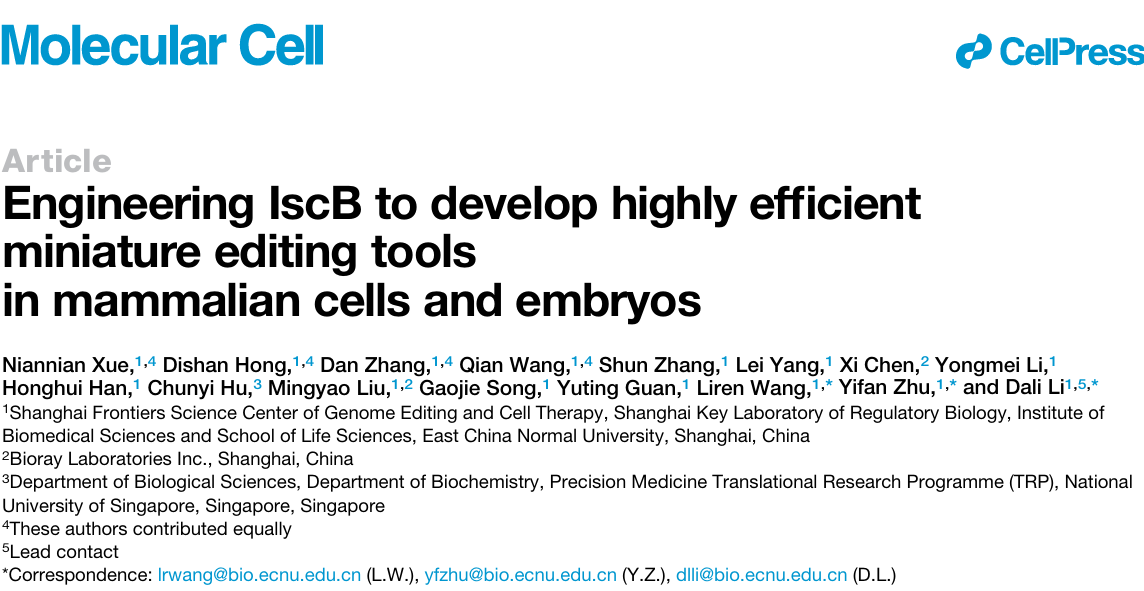

2024-08-02
On August 2, 2024, BRL Medicine Inc. (hereinafter referred to as "BRL Medicine"), which focuses on gene and cell therapy, collaborated with Mingyao Liu and Dali Li's team from East China Normal University to publish a research paper entitled "Engineering IscB to develop highly efficient miniature editing tools in mammalian cells and embryos" in the internationally renowned academic journal Molecular Cell. The report describes the development of a new ultra-high activity and smaller volume gene editing tool based on IscB, providing a new tool for diversified gene therapy strategies. It is worth mentioning that this is another important technological breakthrough with core intellectual property rights in the field of gene editing tool development, following the report on the development of a new cytosine base editor by BRL Medicine team in Nature Chemical Biology in March this year.

A smaller gene editing system: huge potential for clinical application
In 2021, Feng Zhang's team discovered a nuclease named IscB encoded by the IS200/IS605 transposable element superfamily through mining and analysis. As a possible evolutionary ancestor of Cas9, the length of amino acids is only about one-third that of SpCas9. It also uses a non-coding RNA (ωRNA) to guide protein recognition of DNA. However, the reported activity of IscB in mammalian cells was very limited at that time. Taking OgeuIscB as an example, its editing efficiency in HEK293FT cells is less than 5%. Therefore, the primary issue to be addressed is whether it is possible to improve the gene editing activity of IscB through engineering transformation and achieve a comparable level of activity as Cas9.
To improve the activity of IscB protein, the research team successfully obtained an IscB variant (eIscB-D) with ultra-high editing activity in human cells and mouse cell lines through techniques such as protein engineering, RNA structure optimization, and embryo injection. First, based on structural rational design, a mutation was introduced at the key position. After three rounds of iterative screening, an enhanced IscB (named eIscB) was successfully obtained. Compared to the wild-type IscB, eIscB can enhance editing efficiency by up to 22.4 times and increase average editing efficiency by 7.5 times. In addition, the researchers improved the affinity of IscB to target DNA by fusing a non-sequence specific DNA double strand binding protein (HMG-D), and the highest editing efficiency of high activity IscB (eIscB-D) was up to 91.3%. It is worth mentioning that, on this basis, the researchers also optimized and modified the guide RNA to obtain efficient ωRNA (named eωRNA), which was about 20% shorter than wild-type ωRNA. This not only reduced the difficulty of industrial synthesis but also significantly lowered production costs. Moreover, the editing efficiency of eIscB-D/eωRNA was increased by an average of 20.2 times compared to that of the original IscB/ωRNA. In short, eIscB-D is not only smaller in size but also has high editing activity and is an editing system with great potential for clinical application.
In addition, no previous studies have shown that IscB can produce efficient editing in mice. The researchers first screened the targets of PCSK9 and Tyr genes in mouse N2a cell line. The sequencing results showed that eIscB-D could achieve an editing efficiency of 58% at the PCSK9-sg29 target and a 47.1% editing efficiency at the Tyr-sg21 target. The researchers then targeted exon 1 of the Tyr gene through embryo injection with eIscB-D/eωRNA system to disrupt the expression of albinism genes, successfully preparing a mouse model for albinism disease. In the F0 generation, 75% (9/12) of mutant mice achieved high-efficiency editing (average editing efficiency was 58.8%), and five of them produced albino phenotypes with an editing efficiency close to 100%. This study demonstrated for the first time that eIscB-D can not only produce efficient editing in mouse cell lines, but also efficiently prepare disease animal models through embryo injection.
New Mini Single Base Editor: High Activity, Realize Ultra-high Editing Efficiency
As a possible evolutionary ancestor of Cas9, the length of IscB's amino acid chain is only about one-third that of SpCas9, generally only about 400 to 500 amino acids. Therefore, it is expected that IscB can form smaller fusion proteins with cytosine deaminase (APOBEC), adenosine deaminase (TadA) or reverse transcriptase (RT), and construct mini base editors (BE) or pilot editors (PE) that can be completely packaged by single AAV, which has great potential for clinical applications.
Next, the research team developed an IscB nickase (eIscBH339A) by introducing alanine mutations at key catalytic sites in the RuvC domain. They also fused it with adenosine deaminase (TadA-8e) and cytosine deaminase (hA3A*) to develop ultra-high activity mini single base editors eiABE and eiCBE, achieving peak editing efficiencies of 73.6% and 79.2%, respectively.
In general, the research successfully developed a high-activity and mini gene editing tool with independent intellectual property rights, enriched the application scenarios of gene editing tools, and provided more optimal choices for gene therapy. At present, the research team has successfully built a new gene editing nuclease screening platform and is continuously developing and optimizing a new generation of gene editing tools. The goal is to provide solid technical support for innovative drug development and accelerate the transformation of clinical results.